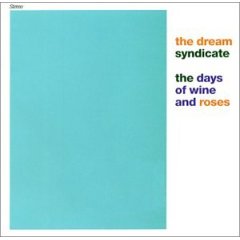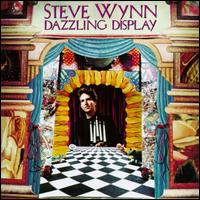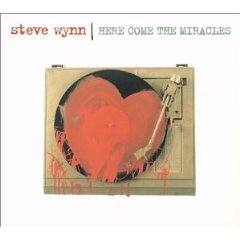FOREWORD: I had the pleasure of meeting former paisley pop underground icon, Steve Wynn, many times in the late ‘90s and thereafter.
As a solo artist, Wynn offered a tremendous kaleidoscopic range of psych-daubed rock material. ‘01s Here Come The Miracles was one of his best and the following piece was done in support.
Afterwards, ‘03s Static Transmission hit the mark, but ‘05s even better tick…tick…tick rocked hardest. In ’07, Wynn and long-time associate, Linda Pitmon, formed the Hazel Motes. This article originally appeared in Aquarian Weekly.
 In the early ’80s, singer-guitarist Steve Wynn led the Dream Syndicate, an influential guiding light of Los Angeles’ short-lived, well remembered paisley underground (alongside the Rain Parade, Bangles, and Green On Red). On his latest solo record, the 2-disc Here Come The Miracles (Down There Records), he ventures into the past, reminiscing about Days Of Wine And Roses while maintaining a morbid view of mortality (declaring “the end of the world’s gonna be a mighty thing/ I’m gonna like the part where the angels start to sing” on the swampwater bluesrocker “Let’s Leave It Like That”).
In the early ’80s, singer-guitarist Steve Wynn led the Dream Syndicate, an influential guiding light of Los Angeles’ short-lived, well remembered paisley underground (alongside the Rain Parade, Bangles, and Green On Red). On his latest solo record, the 2-disc Here Come The Miracles (Down There Records), he ventures into the past, reminiscing about Days Of Wine And Roses while maintaining a morbid view of mortality (declaring “the end of the world’s gonna be a mighty thing/ I’m gonna like the part where the angels start to sing” on the swampwater bluesrocker “Let’s Leave It Like That”).
Yet there’s a sinister playfulness and coy attitude that informs Here Comes the Miracles’ feedback-drenched “Sustain,” the illuminating rave up “Watch Your Step,” and the scraggly Dylanesque “Butterscotch.” He may not be overcome by happiness lyrically, but “Crawling Misanthopic” and the psychedelically glazed “Strange New World” inject a celebratory restlessness that adds to this stunning achievement. Helped along by Arizona desert pals such as organist/ guitarist Chris Cacavas (Green On Red), guitarist Howe Gelb (Giant Sand), and percussionist John Convertino (Calexico), plus guitarist Chris Brokaw (Come/ Codeine/ New Year) and drummer Linda Pitmon, this may be Wynn’s strongest release to date. In general, the first disc’s concise and tightly woven while the second draws outside the lines.
 A brief history is in order. After the Dream Syndicate’s demise, Wynn surprised the underground scene with ‘90s awesome solo debut, Kerosene Man. Then, it seemed as if half the indie rock community (including REM’s Peter Buck and Concrete Blonde singer Johnette Napolitano) played on ‘92s perfectly titled Dazzling Display (which included the mysterious “Bonnie & Clyde,” featuring music written by respected ‘60s lounge-pop master Serge Gainsbourg prior to the French composers’ belated acclaim as a revered lounge-core mentor). Somewhere along the way, Wynn found time to record the hit and miss scuzz pop side project Gutterball with then-semi-popular band House Of Freaks and Bob Rupe of the Silos.
A brief history is in order. After the Dream Syndicate’s demise, Wynn surprised the underground scene with ‘90s awesome solo debut, Kerosene Man. Then, it seemed as if half the indie rock community (including REM’s Peter Buck and Concrete Blonde singer Johnette Napolitano) played on ‘92s perfectly titled Dazzling Display (which included the mysterious “Bonnie & Clyde,” featuring music written by respected ‘60s lounge-pop master Serge Gainsbourg prior to the French composers’ belated acclaim as a revered lounge-core mentor). Somewhere along the way, Wynn found time to record the hit and miss scuzz pop side project Gutterball with then-semi-popular band House Of Freaks and Bob Rupe of the Silos.
Following the hard-to-find, staid folk derivation, Fluorescent, he hooked up with Thalia Zedek’s cathartic band, Come, for ‘96s brooding Melting In the Dark. Meanwhile, ‘97s less ominous, oft-times somber Sweetness & Light and ‘99s resilient My Midnight (which sidesteps murder themes for a softer tone) were recorded for New York’s now-defunct Zero Hour Records and may be temporarily out of print.
FYI: Crime fiction writer George P. Pelecanos (who has used Wynn’s songs as imagery in print) provides an excellent publicity bio that should have been included in Here Come The Miracles’ package. But that’s all that’s missing from this awesome double disc.
 Here Come The Miracles features some of the bleakest lyrics you’ve wrote.
Here Come The Miracles features some of the bleakest lyrics you’ve wrote.
STEVE WYNN: My songs are always pretty bleak, scraping away at the tortured souls and the confusions and internal mess. I like writing about that. I came off a solid year of touring, came out, and spent six months writing songs at home. I’ve never been the type of person who could write a feel good song like “Do Wah Diddy Diddy.” That’s not my speed. I like these freaky dark songs.
I don’t remember you writing about suicide so much. “Southern California Line,” “Let’s Leave It At That, ” and “Sunset To The Sea” deal with pain and mortality.
STEVE: You get the apocalypse, suicide, self-destruction. The Manson Family comes up on “Topanga Canyon Freaks.”
“Topanga” is one of a few songs with recurrent car imagery. “Tequila-soaked backseats” and “Thunderbird Wine.” “Sunset To The Sea” mentions a “V6 engine” that’s “gonna be the death of me.”
STEVE: Cars and trains. There’s a lot of travel themes. I wrote the songs without knowing where I’d make the record. Most songs are about California or the Southwest desert. It was only through circumstances and recommendations that I made the record in Arizona. Once I was out there, I did a batch of sun-baked desert songs. I realized I coincidentally recorded it in the same location I was thinking about. Lyrically and musically, it’s really a West Coast record.
Right. It’s sometimes a reflection of your paisley Dream Syndicate daze. “Shades Of Blue” visits the past with the familiar “Tell Me When It’s Over” guitar riff while the line “if we had our wits and traveled back in time” harkens to Days Of Wine And Roses.
STEVE: It wasn’t really conscious. I wanted the record to move forward while combining places I’d been to before. It reminds me of previous records. A lot of writing I do has been nostalgic. But I’m not one of those people who sits around under a 40-watt bulb bumming out about the past. Let’s face it, you get older and you get nostalgic more so than when you’re 21. “Shades Of Blue” was my attempt to write a prototypical Steve Wynn song.
Your buddy from Green On Red, Chris Cacavas, is prominently featured on this album.
STEVE: We’ve been working together on and off for the last 20 years. I produced his last album and he played on a few tours with me. I knew I wanted this record to be a surprise and a challenge. I wanted to give the reins to someone else now and then. I thought Chris would be a perfect catalyst for that. He’s got a whacked out style and likes throwing a wrench into things and doing the opposite of what you expect. Which is an Arizona mentality. You don’t want to get too professional. You want to panic and have chaos so it’s not quite so settled. The feeling that this could fall apart at any second and catching lightning in the jar.
Along with that risky proposition, you had the audacity to make this a double length album. Happily, the open spaces don’t leave wasted notes in their wake. On “Good And Bad,” Cacavas plays an extended piano solo. Plus, a few songs have long introductions.
STEVE: Yeah. It fit together well. My favorite records have a sense of time and place. This record could only have happened at this time and in that place. At any other time or location, it would be a different record. I don’t like records made by machines that could be made anywhere. This record has a feel and a vibe. I wasn’t planning on making a double record. It just ended up being a good batch of material played well that had a lazy sprawl – this no-hurry-to-get-anywhere desert vibe. It needed space to stretch out in. It sounds like the way you feel driving an old car across the desert and you need a lot of space to get where you’re going. When you’re looking at 100 miles of Mojave Desert you need a lot of space to get where you’re going. You better enjoy the ride.
What’s your opinion on the difference recording on the East Coast as opposed to the West?
STEVE: New York is very no nonsense. The whole New York minute mentality of taking care of business. In the West Coast, especially Arizona, time doesn’t exist. It’s like “I’ll talk to you when the temperature cools down 30 degrees. Making records in New York, I work 16 hour days with a 10 minute dinner break and you have to drag me out of the studio 4:30 in the morning. That’s the energy and speed of New York. In Arizona, you work two hours, then somebody and their brother drop by to talk about cars and tacos for an hour. You go get food, hang out and have a beer. 12 hours go by and it feels like you worked three minutes. The fact of the matter is the laziness lends itself to a certain kind of music.
What have you been listening to lately?
STEVE: The new Buddy Guy record with the Junior Kimbrough songs. I’m a big Fat Possum Records fan. Ever see Kimbrough play?
No.
STEVE: Neither did I. There’s lots of good stuff out now. I bought the Pernice Brothers album and also Joe Pernice’s Big Tobacco record. My favorite record of the last year was the mind-blowing, life changing Primal Scream album XTRMN8TR. It didn’t even make the charts in America.